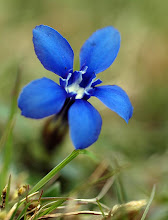One of the best ways to learn more about food is to grow some of the fruit and vegetables from exotic fresh produce that you can buy in supermarkets. Over the years I've grown avocados, litchi, rice, lentils, chickpeas, figs, citrus fruits, lemon grass, ginger, chilli, cape gooseberries, squashes, passionfruit, sesame and pomegranates from supermarket produce - but this was the first time I'd ever grown sweet potatoes Ipomoea batatas.
After a slow start the tuber produces some healthy vigorous shoots but then ....
...... these white granules appeared on the leaves. At first I thought they might be some small insect pest but ...
.... a closer look revealed that they were part of the leaf surface ....and under the microscope ...
..... they turned out to be clusters of swollen, glassy secretory hairs, known botanically as colleters. They're present on upper and lower leaf surfaces.
At higher magnification you can see how inflated the hairs are. They are full of what appears to be ....
...... mucilage that flows out when they burst.
The plant is in a flower pot on a sunny widowsill so the growth conditions are unnatural. Some older leaves have a large number of colleters, others have none.
I don't have any clear idea of what triggers their formation or what their function would be. Some plants dump waste products in leaf surface structures like this and I wondered if they might contain calcium oxalate crystals, that are usually compartmentalised waste products in plant cell vacuoles, because sweet potato tubers do contain calcium oxalate - but I can't see any under the microscope.
Curious. I can only find two relevant research papers.
One, from Brazil and published last year (1), describes secretory colleters in Ipomoea asarifolia, a weedy species that poisons cattle but is also used in herbal remedies.
The other, published in the Australian Journal of Botany a couple of years ago, describes similar structures on the calyx in flowers and fruit of a Ipomoea cairica (2), and the authors speculate that the secretion, which crystallises but is hygroscopic and becomes a gel in moist conditions, may have a role to play in protecting the plant from drought. That seems plausible, because the south-facing windowsill where the plant stands gets very warm on sunny days.
So maybe by producing these colleters the plant is telling me that its too hot and needs to be watered more often ...
Sources:
1. Martins, Fabiano M.; Lima, Jamile F.; Mascarenhas, Ana
Angelica S.; et al.(2012) Secretory structures of Ipomoea asarifolia: anatomy
and histochemistry. Revista Brasileira de Farmacognosia – Brazilian Journal of
Pharmacognosy. Volume: 22 Issue: 1 Pages: 13-20
2. Sousa Paiva, Elder Antonio; Martins, Luiza Coutinho (2011)
Calycinal trichomes in Ipomoea cairica (Convolvulaceae): ontogenesis, structure
and functional aspects. Australian Journal of Botany. Volume: 59 Issue: 1 Pages: 91-98






















